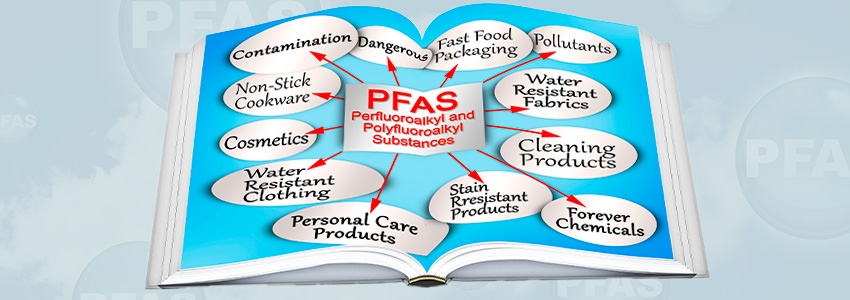For decades, Per- and Polyfluoroalkyl Substances (PFAS) have been integral to numerous industries, valued for their remarkable resistance to heat, water, and oil. From non-stick cookware to water-resistant clothing and firefighting foam, these synthetic chemicals have found widespread use and purpose. However, their enduring presence in the environment and potential health risks have sparked scrutiny in recent years.
Known as "forever chemicals," PFAS compounds, including the infamous PFOA and PFOS, are shown to linger persistently. Delving into the history of PFAS is essential to grasp the gravity of current challenges and to craft effective strategies for mitigating their impact on health and the environment.
Discovery and Expansion of PFAS
PFAS were first developed and synthesized during the 1930s and 1940s. One of the earliest uses was Teflon, created by DuPont, which showcased PFAS' superior resistance abilities. By the 1950s, PFAS use expanded significantly, finding applications in numerous sectors.
Common Products and Applications:
- Cleaning Supplies
- Non-stick cookware (Teflon)
- Water-resistant clothing
- Firefighting foams
- Stain-resistant fabrics and carpets
- Food packaging materials
Emerging Concerns About PFAS
Early Warnings in the 1960s and 1970s:
- Initial studies and reports began to raise alarms about the potential environmental and health impacts of PFAS.
- Researchers started to identify the persistence of these chemicals in the environment and their accumulation in living organisms.
Signs of Environmental and Health Risks:
- Evidence of PFAS contamination in water sources, wildlife, and human populations started to emerge.
- Studies linked PFAS exposure to various health issues, including cancer, liver damage, and developmental problems in children.
- Increasing concern over the bioaccumulative nature of PFAS, leading to long-term exposure risks.
Regulatory Actions and Public Awareness
Key Studies and Reports in the 1990s and 2000s
- Landmark studies highlighted the widespread presence of PFAS in the environment and their potential health risks.
- Reports by agencies such as the EPA and independent researchers provided crucial data on PFAS contamination and its impact on human health and ecosystems.
- These studies raised public awareness and prompted further scientific investigation into the effects of PFAS.
Major Lawsuits and Regulatory Responses
- Significant lawsuits against companies like DuPont and 3M brought attention to PFAS contamination and the need for regulatory action.
- Settlements and court rulings led to increased scrutiny and tighter regulations on PFAS production and use.
- Governments and regulatory bodies introduced guidelines and limits for PFAS in drinking water and other environments to protect public health.
- Ongoing legislative efforts aim to phase out certain PFAS compounds and promote safer alternatives.
For industries seeking safer and more sustainable alternatives, Techspray offers PFAS-free solutions that minimize environmental impact while maintaining high performance.
Current Status and Future Outlook
Ongoing Research and Regulations:
- Continuous research is expanding our understanding of PFAS, focusing on their health and environmental impacts.
- New studies frequently emerge, providing insights into contamination levels, exposure pathways, and associated risks.
- Regulatory bodies worldwide are updating and tightening regulations to control PFAS emissions and usage.
- Enhanced monitoring and remediation efforts are being implemented to address existing contamination in water, soil, and air.
Development of PFAS-Free Alternatives:
- Significant investments are being made to develop PFAS-free alternatives for various applications.
- Innovations are leading to safer materials that can replace PFAS in products like non-stick cookware, water-resistant clothing, and firefighting foams.
- Companies like Techspray are at the forefront, offering a range of PFAS-free products, including wipes, swabs, and solvent replacements.
- The shift towards PFAS-free solutions is driven by regulatory pressures, increased consumer awareness, and a commitment to environmental sustainability.
The history of PFAS reveals a complex journey from their initial discovery and widespread industrial use, to the emerging concerns about their environmental and health impacts. Key developments over the decades have highlighted the persistent nature of these chemicals and the significant risks they pose. The ongoing research, regulatory actions, and industry efforts to develop PFAS-free alternatives emphasize the importance of continued vigilance and innovation.
By learning from the past and staying informed about current developments, we can better manage the challenges associated with PFAS and work towards a safer and more sustainable future.
Techspray’s PFAS-Free Products:
Contact us at Techspray for high-quality PFAS-free solutions!




